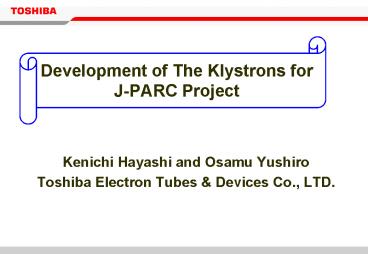Development of The Klystrons for JPARC Project - PowerPoint PPT Presentation
1 / 23
Title:
Development of The Klystrons for JPARC Project
Description:
By unifying the tube with the focusing solenoid to provide adequate mechanical strength. ... Focusing solenoid. Interaction cavities. Electron gun. Oil tank ... – PowerPoint PPT presentation
Number of Views:78
Avg rating:3.0/5.0
Title: Development of The Klystrons for JPARC Project
1
Development of The Klystrons for J-PARC Project
- Kenichi Hayashi and Osamu Yushiro
- Toshiba Electron Tubes Devices Co., LTD.
2
Contents
- Outline of the J-PARC project
- What kinds of klystron are used?
- What are the klystrons like?
- 324 - MHz, 3 - MW Klystron E3740A
- Design
- Test results
- Some of problems
- 972 - MHz, 3 - MW Klystron E3766
- We are now developing this tube.
- Brief on design and test results
- Summary
3
J-PARC at JAERI Tokai site
Nuclear and Particle Physics Facility
Materials Life Science Facility
3 GeV Rapid Cycling Synchrotron (350 m)
Linac (350 m)
50 GeV Synchrotron (1600 m)
Accelerator-Driven Transmutation Experimental
Facility
Neutrino Experimental Facility
4
The 400 MeV Linac of J-PARC
- The linac requires two types of klystron.
- 20 of the 324-MHz klystron, E3740A are used at
DTL. - 23 of the 972-MHz klystron, E3766 are used at ACS.
E3740A
E3766
5
Specs Design Parameters of the Klystrons
Triode-type electron gun for anode modulating
6
324-MHz Klystron E3740A Overall Design
- Aim of designing (against growing in size due to
low operating frequency) - To reduce size and trim weight
- By unifying the tube with the focusing solenoid
to provide adequate mechanical strength. - By trimming each component.
- Limitation of the building and easy handling
- By placing the tube horizontally.
about 65 lighter than the same-size tube we have
developed.
7
E3740A Klystron Klystron Assembly
Output window
5 m
3,200 kg with oil
Focusing solenoid
Oil tank
Klystron
Stand
8
The photo of the E3740A
9
E3740A Design of the electron gun
- To reduce the surface gradient by optimizing the
electrode configuration. - To assure long life and stable emission by
adopting metal-coated cathode.
Cathode terminal
Anode terminal
Body
- Beam trajectory from EGUN
- Beam diameter 30 mm
- Beam ripple lt 3
- Surface gradient 65 kV/cm
94 kV
Anode
Cathode
110 kV
10
E3740A Design of the interaction circuit
To shorten the tube length by 25 using the 2nd
harmonic cavity
Gun side
Collector side
Optimizing the parameters using FCI (Field Charge
Interaction 21/2 PIC code)
11
E3740A Design of the output circuit
T-bar structrure To simplify the
coaxial-to-rectangular conversion section.
Qext 13
wave
wave
T bar
Output cavity
WR2300
Window ( TiN coated Al2O3)
The simulation was done using HFSS codeModel and
result.
12
E3740A Test Results 1
t 0.1 ms/div
Transfer characteristics
Traces of the beam wave parameters
(a) Beam voltage 110 kV, Anode voltage 91.7 kV,
Beam current 48.2 A
(b) Beam voltage 104 kV, Anode voltage 86.5 kV,
Beam current 43.5 A
13
E3740A Summary of Operation
14
E3740A Problem 1, Oscillation
- Oscillation at the main frequency
- We observed oscillation at 324 MHz at the beam
voltage above 90 kV for the first tube. - Power level of the oscillation reached up to 300
kW.
- We found from various experiments and analyses
that - The oscillation occurred in the input cavity.
- Due to reflected electrons from the collector.
- Measures
- Enlarging the collector to decrease the reflected
electron. - Lowering the external Q factor of the input
cavity.
15
E3740A Change in collector size
The first tube
The second tube
The final tube
0.07
0.34
0.18
Ratio of reflected electron to incident beam
16
E3740A Magnetic field distribution
- We observed during the test of the second tube
that the output power sometimes failed at random.
Inner diameter of drift tube f70 to f100
Confined slow ions and electrons
17
972-MHz Klystron E3766 Overall Design
- The tube has the same beam parameters as the
E3740A to use the common power supply system. - 6 cavities for broad bandwidth 10 MHz (-3 dB).
Collector
Output window
2.93 m
Interaction cavities
Electron gun
18
E3766 Test results
- We are now testing the tube and we have confirmed
that - an output power of up to 2 MW was obtained at a
beam voltage of 97 kV with an efficiency of 52. - We intend to achieve 3-MW output by this
September.
19
Summary
- The 324-MHz, 3-MW, long-pulse klystron E3740A has
been developed in collaboration with KEK and
JAERI. - We have confirmed
- The maximum power of 3.03 MW.
- Stable operation with efficiencies above 56.
- The tube is put into commercial production
- We have already produced 13 sets, and we intend
to produce 20 sets in total by this September.
20
(No Transcript)
21
E3740A Test Results 2
Saturation characteristics
22
E3766 Design of the electron gun
Same design principles as the E3740A
- To reduce the surface gradient by optimizing the
electrode configuration - To assure long life and stable emission by
adopting metal-coated cathode
Beam diameter 21 mm Drift-tube diameter 30
mm Beam ripple lt 2 Surface gradient 65 kV/cm
at 120 kV
Beam trajectory from EGUN
23
E3766 Design of the output circuit
- To shorten the output circuit by using
step-waveguide structure. - A single-gap re-entrant cavity with an iris is
used.
Qext 16
wave
WR975
Pillbox window ( TiN coated Al2O3)
Output cavity
The simulation was done using HFSS codeModel and
result.































